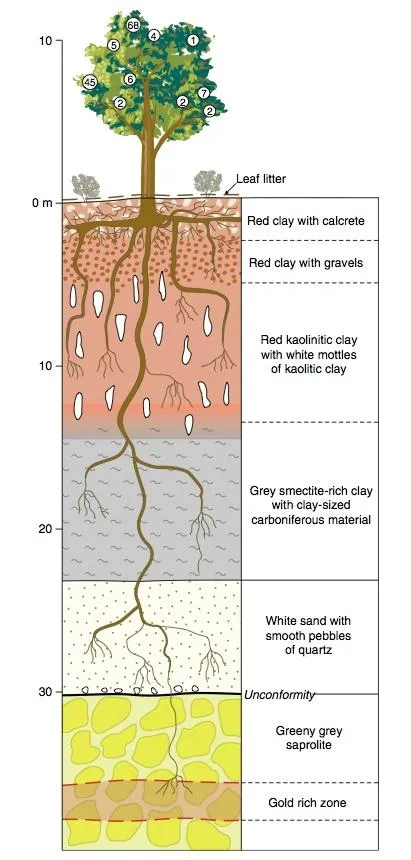Gold Particles in Eucalyptus Trees Can Reveal Deposits Deep Underground
The plants can absorb gold particles in their roots and transport them up to their leaves—a finding that could be a boon for mining companies
/https://tf-cmsv2-smithsonianmag-media.s3.amazonaws.com/filer/Surprising-Science-Eucalyptus-trees.jpg)
If you traveled to the town of Kalgoorlie, in Western Australia, then headed about 25 miles north, you’d eventually reach a grove of large eucalyptus trees, some more than 30 feet tall, scattered across a dusty, arid landscape. Examining the dirt at your feet would reveal no trace of the gold deposits that lie roughly 100 feet underground, due to the thick layers of clay and rock that sit atop the precious metal.
But, scientists recently learned, if you peered closely enough at the eucalyptus trees—specifically, using X-rays to detect nanoparticles—you’d find that there’s gold in them thar leaves. As detailed in a study published today in Nature Communications, a group of researchers from Australia’s Commonwealth Scientific and Industrial Research Organisation has shown that plants can absorb gold particles deep underground and bring it upward through their tissues—a finding that could help mineral exploration companies mine for gold.

“In Australia, we’re faced with this problem of trying to explore through thick layers of sediments and weathered rock to reach valued minerals,” says Melvyn Lintern, an Earth scientist and lead author of the study. “At the same time, we’d previously heard from mining engineers that, in some places, they’d found eucalyptus roots going down to 30 meters or deeper in the mines.” With this observation in mind, and the knowledge that plants can absorb and transport minerals from the surrounding soil and bedrock all the way up to their leaves, Lintern and his colleagues were struck with an idea: Why not test eucalyptus leaves to see if they could indicate underground gold deposits?
To do so, they visited two Australian sites with known gold deposits deep underground (as revealed by exploratory drilling) that were covered by thick layers of rock and on top of which grew tall eucalyptus trees. When they tested leaves that grew on or had fallen from the large trees in both areas, they indeed found minute traces of gold—up to 80 parts per billion, compared with the 2 parts per billion they found in leaves that had grown 650 feet away from the underground deposit.
Other researchers had detected gold particles in plants and leaf litter before, but it was unclear whether they’d been transported all the way from underground deposits. “We were concerned that the gold might have been occurring as dust particles on the outside of these leaves, so it was important for us to locate the gold within the plant,” says Lintern.
His team did so by analyzing the leaves in even further detail (using a specialized X-ray microprobe located at the Australian Synchrotron research facility) and confirmed that the gold particles were located within the plant’s vascular tissue, indicating that they were moving naturally within the leaves. They also conduced greenhouse experiments and found that eucalyptus saplings, grown in soil laced with similar levels of gold, absorbed it and transported detectable levels into their leaves. These separate streams of evidence, they say, shows that the wild eucalyptus trees were indeed sucking up gold from deep underground.
“The eucalyptus acts like a hydraulic pump,” using its roots to suck ground water upward, crucial in an arid environment, Lintern says. “The plants, of course, are searching for water, not gold, but it just so happens that there’s gold dissolved in it.”
The fact that the gold has been found in the leaves, in fact, might be evidence that the eucalyptus is actively trying to get rid of it—after all, it’s a toxic heavy metal—by transporting it to its extremities. Additionally, the gold particles in the leaves were often found located near calcium oxalate crystals, theorized to be part of the removal pathway for toxic chemicals.
Lintern’s group plans to conduct further research into which plants are capable of transporting gold particles in this way and what environmental factors affect the rate of uptake. Mining companies in Canada, he mentions, have already toyed with the idea of using plants as mineral indicators, so this first scientific evidence for the process is likely to accelerate adoption of the method.
“Essentially, we’re tapping into a natural process,” Lintern says. In an age when most of the readily accessible gold near the planet’s surface has been mined, it makes sense to harness the natural mineral exploration plants are already engaging in when they drive their roots deep into the ground. Doing so might even reduce the number of exploratory mines we’re forced to drill—and consequently, lead to less environmental destruction of these plants’ habitats as a result of mining.
/https://tf-cmsv2-smithsonianmag-media.s3.amazonaws.com/accounts/headshot/joseph-stromberg-240.jpg)
/https://tf-cmsv2-smithsonianmag-media.s3.amazonaws.com/accounts/headshot/joseph-stromberg-240.jpg)